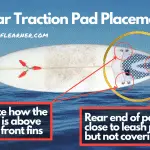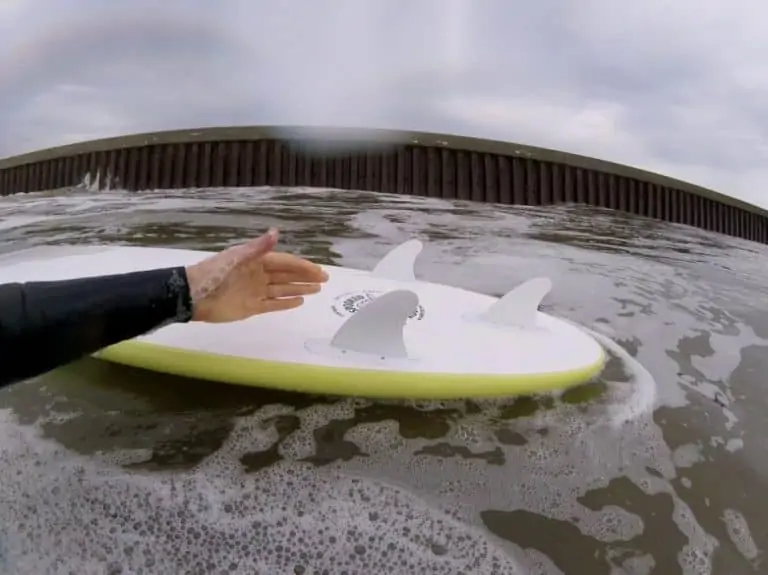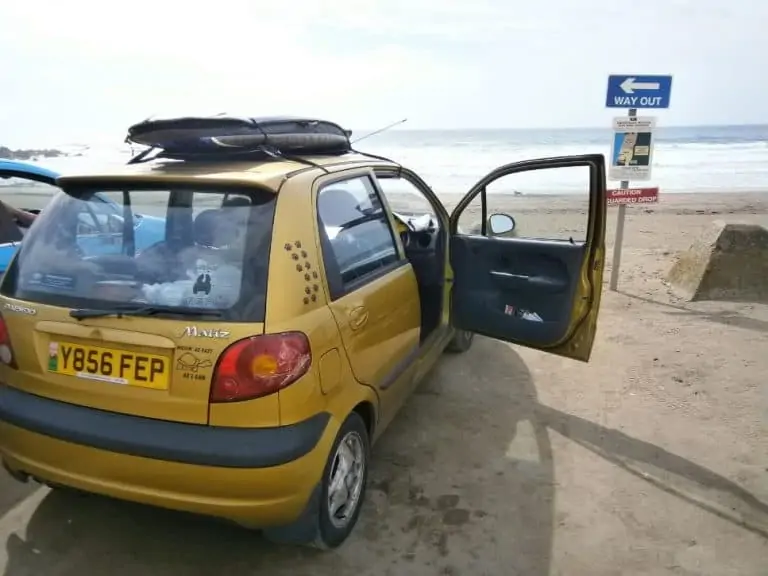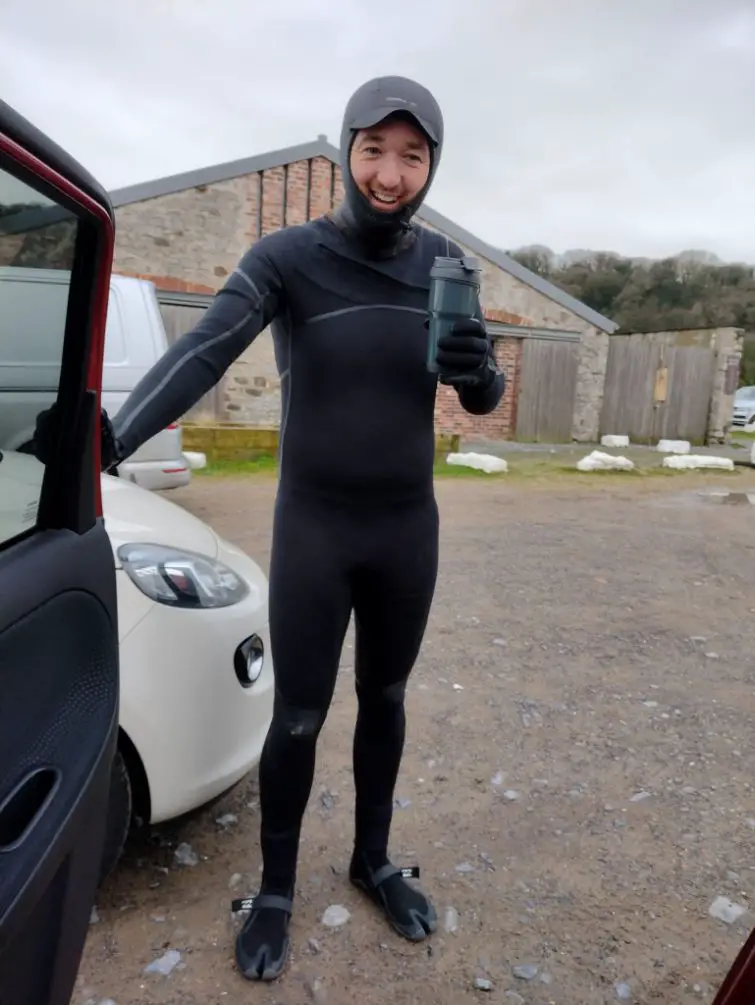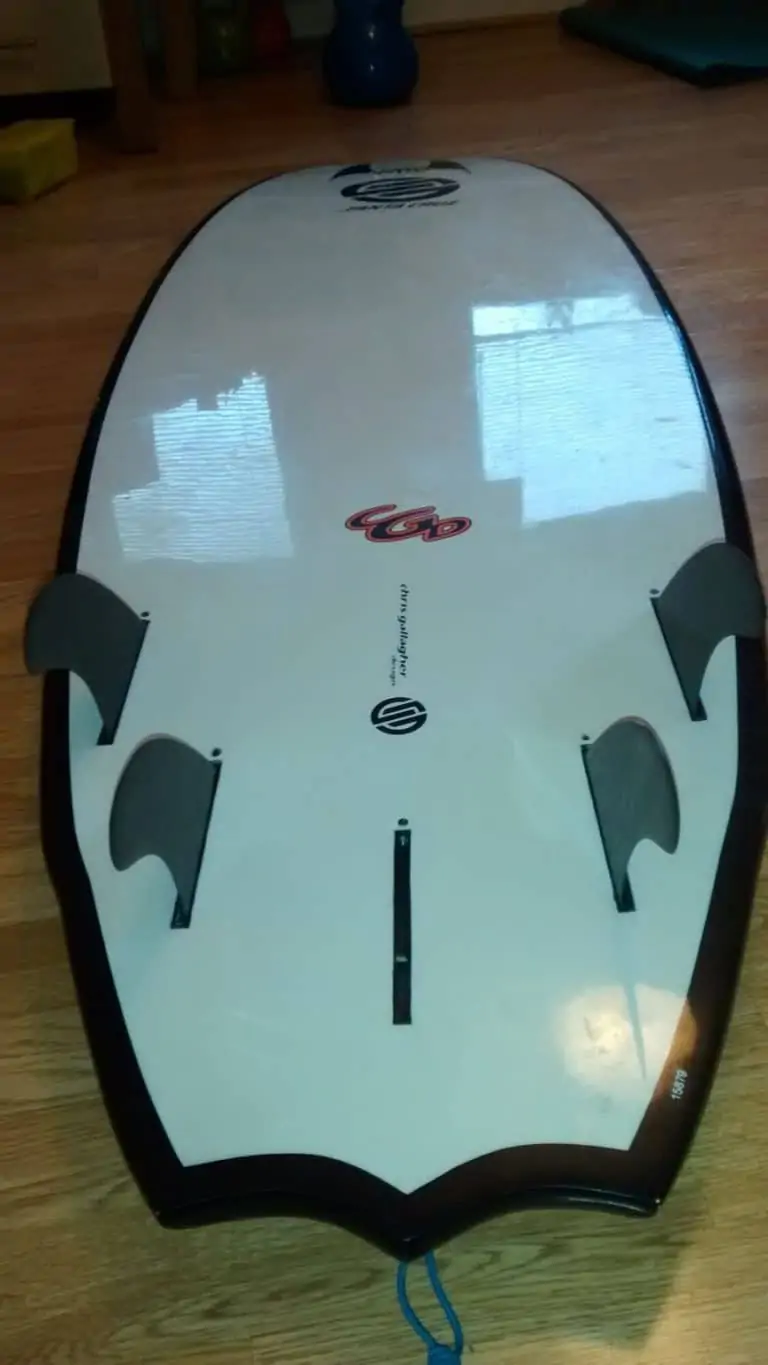Do You Need a Traction Pad for Your Surfboard? (Maybe + When)
When buying a surfboard, there are plenty of accessories and surf gear items that you can get to go with your board.
Surfboard fins, and a leash are a necessity, but since you are wondering whether you need a traction pad on your surfboard, here’s my definitive answer:
You don’t need a traction pad to learn to surf but they are helpful for extra grip when doing turns as you progress. Traction pads are also better suited to shorter surfboards, under 7 feet but note that they can’t be used with soft-top learner surfboards, as we’ll look at below.
What is a traction pad?
Before jumping in, let’s just be clear about the terms we are talking about.
A traction pad on a surfboard is a soft foam pad that you glue onto your board for extra grip. Most pads are for the rear of a board, hence the name ‘tail pad’, although there are more and more front pads available these days.
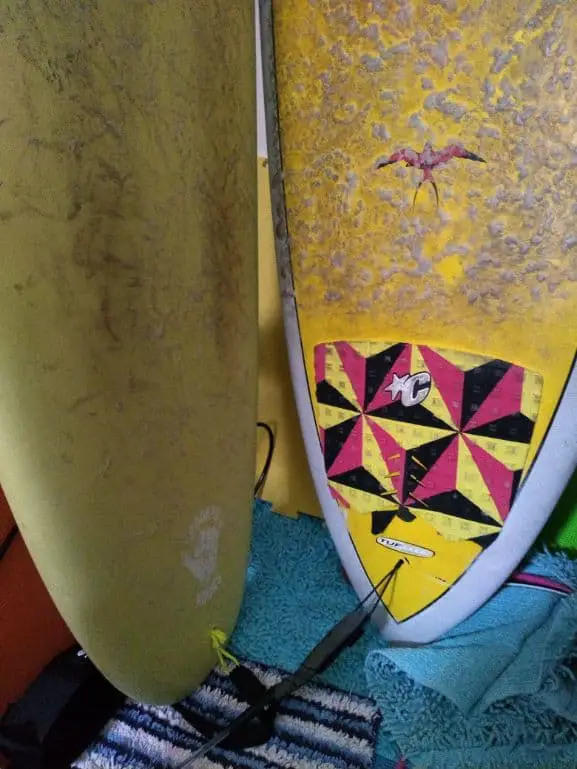
Rear traction pads come with an arch in the middle and a ‘kick’ at the back. The arch helps you to center your foot on your tail pad without looking down while the kick stops your foot from sliding off the end when pushing hard through a turn.
Types of Surfboard
The main points to consider around whether or not to get a traction pad are the type of surfboard you will be using.
This is because lengths, constructions and styles can all determine whether a traction pad, or ‘stomp’ pad, will actually help you and make your surfing experience better.
Longboards
Most longboard riders do not need a traction pad on their board. This is largely due to the length of the board and the way in which longboards are ridden.
If you think that longboards are anything over 9 feet in length, being the longest type of pure surfboard, then you can see that a single traction pad that is a mere 15-20 inches long isn’t going to be that noticeable since it will only cover a tiny amount of the board.
Combine this with the fact that the fin(s) on a longboard are further forward than most other surfboards and you have a design that does not lend itself well to being turned from the most extreme point of the board at the rear.
Nose Riding
If you want to progress as a longboarder, you will also want to try walking up and down the board, even if you don’t make it right to the nose for a full hang ten or even hang five.
Having a traction pad can actually get in the way when walking a longboard since it will mean that you have to step up a little when walking up your board; even though this will only be by half an inch or so, being on a wave while doing this quickly could really throw you off.
It would also mean that you have two different types of surface to walk along, so changing the grip under your feet depending on where they are.
For these reasons, traction pads are not recommended for the majority of longboards, unless you really want to add them for a specific reason. If so, then go for longboard-specific traction pads as these will be thinner and less of an obstacle when walking up and down your board.
Funboards or Mini Mals
On longer, wider and more generous templates like funboards or mini mals, traction pads are really down to the personal preference of the rider.
In this article, we’ll consider funboards ones that are specifically for learners, while mini mals (short for ‘mini malibu’, with Malibu boards the original name for longboards) are anywhere from about 7 feet to 8’6”.
The bigger your board, the less likely that you will need or want a traction pad. This is because bigger surfboards are harder to turn. Traction pads are most helpful when trying to turn hard and quickly, something that you just can’t really do on these kinds of boards, so their use and benefits are limited.
That said, if you have something like four quad fins on a shorter board in this range, then you might find you get some use from them.
The main advice here you would be to try without and see if you feel like a traction pad might help; this would be most helpful if you want to try and turn the board hard but your back foot keeps slipping off.
Soft Top Foam surfboards
Soft top foam surfboards do not work well with traction pads, so it is recommended that you do not get one if you have a surfboard in this construction.
The main reason is because of the difficulty in getting the glue on the traction pad to stick to the soft foam. Not only does this foam move, it’s also more grippy than a standard fiberglass surfboard anyway, so you wouldn’t get as much benefit from a pad, if you could get one to stick, that is!
Remember that soft top surfboards are more for having fun and cruising on, which kind of goes against the purpose of a traction pad.
Shortboards
Traction pads are extremely popular with shortboarders, with almost all of them using a tail pad on their surfboard for added grip and control.
This is mainly because shortboards are designed for more aggressive turns, so anything that helps to push the board around a little more is extremely helpful.
By far the most popular choice of pad on a shortboard is the tail pad since this helps to maximize the torque you can get when changing direction.
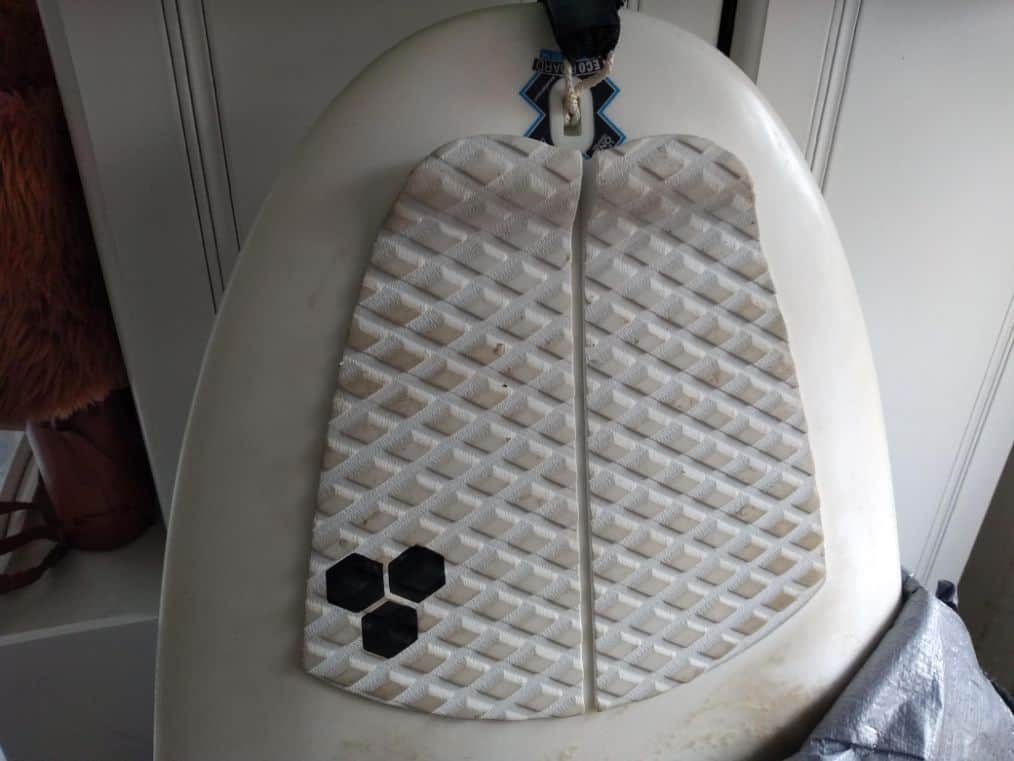
The added texture and grip that this gives your shortboard can transform the feeling. This might also be evidenced by the fact that almost all professional (shortboard) surfers use rear traction pads all the time, which speaks volumes about the utility of these pads.
In case you are still not sure, to help you make your decision, I’ve also included the main pros and cons of riding with these pads in the sections below.
Pros of a Surfboard Traction Pad
In general, the main pros of riding with a traction pad on your surfboard are as follows:
- Extra grip
- Set it and forget
- No more wax
- Tail pads help with hard turns
- Kick and arch can help with airs
They offer extra grip in that their pattern has lots of beads and bumps on them, and they have been designed specifically for added grip. This means that you know that you will have a reliable patch of grip on your board every surf.
This then leads on to the next major advantage of traction pads, being that they are lower maintenance than wax. After you put a traction pad on your surfboard, provided that it’s done correctly, you won’t have to think about waxing that part of your board again.
Compare that with wax that needs constant applications and combing and it becomes a lot easier. Depending on how long you have your surfboard for, it might also work out cheaper in the long run if you think that one tail pad is about the same price as 10-15 bars of surf wax, which you could definitely get through on a surfboard with heavy use over several years.
Traction pads, specifically tail pads, are also great for doing hard turns on a surfboard.

Photo Credit: Peter Gonzalez on Unsplash
This is because of the kick at the back, as mentioned earlier in this article, which gives you an angled bit of pad to push back against. When going through some more advanced turns like a cutback, where you weight will shift a lot, the kick can be helpful to keep your foot firmly on your surfboard right through the maneuver.
On top of this, if you want to go for arguably the hardest maneuver in surfing, the air, then a tail pad can also help with this. Similar to a skateboard, the kick can help you to ollie your board out of the lip and project into the air, while the arch can help after the landing.
As you can see from the above, a traction pad is really helpful with some of the more advanced maneuvers in surfing on a shortboard, while also providing more grip even when just getting to grips with a shorter board.
Cons of a Surfboard Traction Pad
Having considered all the good points of getting a pad, let’s now look at the cons of pads n your surfboard, summarized as follows:
- Placement needs to be exactly right
- Hard to remove
- Can come off
- More expensive than wax
So, to get any benefit from a traction pad, you will need to place them in exactly the right spot on your surfboard. This means knowing where to put it on your board and being precise.
As a general rule for shortboards, the further back your rear traction pad is the better. This is because you want it over your fins to give you most help when turning. However, if you get this slightly wrong, then you will come across the next problem with these kinds of pads, that they are really hard to remove.
Given that you need to have the pad perfectly aligned when you start, it’s quite easy for them to go off at an angle, making your board look wonky and your pad feel awkward underfoot given the slight angle.
If you mess this up, you either have to try and peel the pad off before the adhesive really takes hold, or just tough it out and spend hours cleaning off the pad in bits (something I did once and would not recommend it!).
To get your traction pad to stay on, you will also need to make sure that you clean your board extremely well before applying it. This means using white spirit, or a similarly strong cleaning agent, to get rid of any kind of oil, dust or other residue; this applies to brand new surfboards, too, since they often come with a layer of dust from the factory where they were produced.
However, if you don’t get this right, your pad will likely start to peel off after a few surfs, again leading to the frustrating task of having to take the rest off, clean up, buy a new pad and start again!
The upfront cost of a traction pad is also more than surf wax, so you buying one is more expensive in the short term; that being said, these pads could also last a long time so this may not be such an issue in the longer term.
Alternatives to a Pad
The main alternatives to using a pad are surf wax and a special deck grip sticker for surfboards.
Surf wax is the traditional and standard option and, as mentioned above, can come in at a lot cheaper than a traction pads but definitely needs more work on a regular basis to keep it grippy, be it through reapplication or by roughing up your wax with a wax scraper.
The newer deck grip for surfboards, led by the brand RSPro with their patented ‘HexaTraction’ stickers, offer a sticker that replaces wax.
However, it should be noted that these stickers are much more for the front of a surfboard, so you could combine one of these grip stickers up front with a tail pad at the back, which could be a good option for long-term use.
Related Questions
How long does it take for a traction pad to dry? 24-48 hours. The instructions that come with your traction pad will tell you exactly how long the manufacturer recommends, which is usually 24 hours. But, to be extra careful, leave it 48 hours.
The extra day’s wait will be worth it as your traction pad will be far less likely to come off after a few surfs, which is exactly what happened to me when I was impatient and surfed less than a day after applying a new pad to my board.
Should you put a traction pad on a fish? Yes, a traction works very well on a fish surfboard as it will help you to push the board through turns quickly. Since a fish is an agile and loose surfboard design, rear traction pads work the best.
What can I use instead of surf wax? Traction pads or newer grip stickers can be used as an alternative to surf wax. However, you can’t really use other types of wax like beeswax or candle wax since this will turn hard and probably hurt you!
